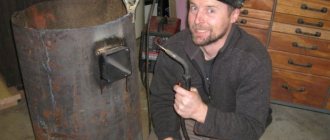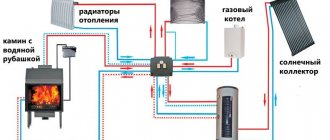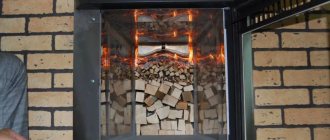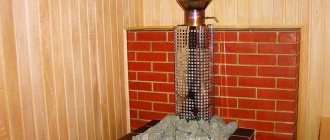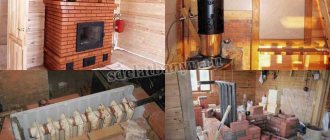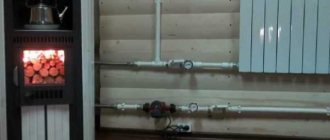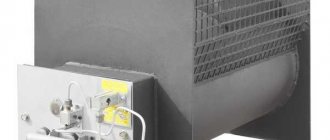With rising energy prices, more and more people are seeking to obtain as much energy as possible from sources previously considered waste. In this case, used oil, household waste, and old car tires are considered as fuel.
Today we will talk about how to build a sawdust stove inexpensively and with your own hands, and it will be a unit that works on the principle of long-term combustion.
After all, it will not be a secret to anyone that in our country there are regions where wood chips and sawdust can be used for heating for practically nothing, except for the cost of their delivery.
Smaller area – less heat
There are long-burning stoves with connected water and air circuits. Thanks to this, a sawdust stove can heat a fairly large area.
In the article about heating stoves for greenhouses, we have already considered a do-it-yourself version of a sawdust stove, but this version of the stove is capable of heating a relatively small area, and this is not due to the lack of a water or air circuit, but to the small area where hot gases are used.
The figure shows drawings of this furnace.
Sawdust stove from a 200 liter barrel
Furnace heating area
As you can see, when fully loaded, the thermal area of the furnace is approximately 1/3 of the total area . In the figure, this area is highlighted with red shading.
With this arrangement, there is a loss of thermal energy escaping through the chimney. Of course, you can try to get as much heat as possible by increasing the length of the chimney through the heated room. But this is not entirely rational, and in some cases it is simply impossible due to the design features of the room and its area.
This long-burning sawdust stove is good for its simplicity, because by and large it can be made within a few hours from scrap materials.
Design features
The specificity of fuel such as sawdust is that its particles are tightly pressed against each other and prevent the penetration of oxygen necessary to maintain the combustion process (those who have had to deal with coal know that for the same reason large stones burn much better than coal crushed into dust).
Therefore, the main structural difference between such units is the method of delivering air to the “heart of sawdust”.
They are tightly packed into a cylindrical combustion chamber, and a conical rod is inserted in the central part.
During combustion, the rod is removed and a vertical channel is formed - an adit, through which air moves. Sawdust burns layer by layer from the middle.
And this combustion occurs very slowly, in smoldering mode.
There are several modifications of such heating devices:
- One or two holes for the chimney.
- One or two walls.
- Remote or built-in ash drawer.
Note. The stove is made from a two-hundred-liter barrel and can be heated with one load of sawdust for 10 hours.
Solving the problem - circuit design
But today we are interested in a long-burning sawdust stove, which can be used to heat rooms as large as possible.
Of course, you will need to install a water or air circuit, but first let’s solve the question: is it possible to increase the thermal area in a stove of this type without increasing the length of the chimney?
External circuit device
The first one shows a long-burning stove with an external smoke circuit. The device completely replicates the previously presented sawdust stove. The only changes are the circuit through which the hot flue gases pass and the lower position of the chimney.
The first one shows a stove with an external smoke circuit. The device is completely identical to the previously presented oven. The only changes are the circuit through which the hot flue gases pass and the lower position of the chimney.
As you can see, the changes made it possible to significantly increase the thermal area of the long-burning furnace without increasing the length of the chimney. The volume of the firebox remained unchanged.
As you can see, the changes made it possible to significantly increase the thermal area of the furnace without increasing the length of the chimney. The volume of the firebox remained unchanged.
Internal contour of a sawdust stove
In the second case, the internal circuit is installed inside an existing furnace. The thermal area has also increased. The only drawback of this installation is the reduction in sawdust loading volume.
But there is also an advantage: setting up such a circuit will not be difficult; the only thing required is installing a 200-liter barrel of a smaller diameter inside and rearranging the chimney.
As you can see, a small modification will significantly increase the efficiency of using such a seemingly simple stove.
Review of brick kilns
There are many models of furnace devices, which are different both in their form and in their functions. The most popular are Russian, Dutch and Swedish stove units. They are slightly inferior to the Finnish, Kuznetsov stove and housekeeper.
Russian stove
This multifunctional design with large dimensions is one of the oldest models. In past times, it was very common: in every home, the presence of a beautiful Russian stove was mandatory.
Russian stove
The main advantages are:
- possibility of heating the room, beds;
- cooking food;
- use as a drying device for clothes and shoes;
- With regular heating, it provides an even, long-lasting temperature;
- creates a special Russian flavor and will become the main decoration of any room.
Despite their advantages, such brick stoves for wood-burning homes have several disadvantages:
- massiveness requires the installation of a solid foundation;
- occupies a significant area in the room;
- the need for regular cleaning;
- difficulty in installation;
- The efficiency is only 60 percent.
Dutch
Another very popular model is the Dutch oven. This design, which looks like a column, really appealed to the owners of country houses and small-sized premises. Its height is significantly greater than its width, so the Dutch model takes up little space.
Dutch oven
Advantages of a brick stove for a Dutch-type wood-burning cottage:
- compactness;
- low cost of masonry material;
- possibility of rapid heating due to thin walls;
- long breaks between fireboxes do not affect the quality of heating;
- You can heat a medium sized room.
Disadvantages of this model:
- relatively low efficiency, which is equal to 40 percent;
- requires regular cleaning of the ash pan. Without proper care, cravings can get worse;
- requires constant attention during combustion and some skills in maintaining the fire.
Swede
This model is designed taking into account the cold climate of northern countries, so it is ideal for our region.
Stove "Swedish"
Advantages of this model:
- compactness;
- high performance;
- fast heating;
- possibility of heating adjacent rooms.
Flaws:
- the cost of construction increases due to the use of fireclay bricks;
- the need for good thermal insulation to avoid heat loss through the floor;
- not suitable for houses and areas that are rarely heated. If it cools completely and is not heated frequently, the furnace masonry may be damaged.
Housekeeper
This small Russian brick stove for a summer house or home can be installed even in a small room. Its design is very simple, but the oven can also be used for cooking. This model is becoming increasingly popular, because its dimensions contribute to the rational use of space.
Housekeeper
Advantages of the economy stove:
- does not take up much space;
- heats the room well;
- you can cook food.
Flaws:
- You cannot fire two fireboxes at the same time;
- requires constant ash removal;
- takes time to heat up;
- For better combustion, you need to use firewood of noticeably the same thickness.
Finca stove
This heating device differs from other types in its special design: one firebox body is located inside the other.
"Finka"
Advantages of the furnace unit:
- high heat transfer efficiency;
- ease of manufacture;
- low cost;
- fast heating;
- safety and environmental friendliness.
Disadvantages of this type of furnace device:
- relatively large dimensions;
- It is necessary to carefully monitor the amount of fuel in the firebox.
Kuznetsov furnace
The heating device received its name thanks to the name of the developer Kuznetsov. The operating principle of such a unit is based on the movement of free gases.
Kuznetsov furnace
Advantages:
- excellent thermal efficiency;
- complete combustion of fuel;
- no soot;
- a small amount of masonry material.
Flaws:
- difficulty in installation due to the design;
- high requirements for material;
- Some skills are required to fire such a device.
Other stove models
In addition to the above models, there are other, less common:
- V. Bykov's stove, which is only suitable for heating a small room;
- Podgorodnikov’s two-bell stove, which can be heated with either coal or wood.
New system on old principles
Sawdust boiler with a register for connecting to a radiator heating system
But that's not all. A homemade sawdust stove allows you to create even more efficient designs.
The picture shows a long-burning boiler with the ability to connect to a water heating system. What’s remarkable is that the boiler can be made with your own hands; it works on sawdust, small wood chips and various household waste. But of course, first of all, it is designed to work on sawdust.
Cover with blower
Upon closer examination, our readers will notice some similarities between this boiler and the Bubafonya stove. But it is not so.
The pipe passing through the lid, although it is a blower, does not have the shape of a piston and is completely motionless when the boiler is operating. This picture shows a fully charged boiler. As you can see, the pipe is recessed almost completely inside; in a “bubafoni” it would protrude significantly from the boiler.
Sawdust and wood chips: their effectiveness as solid fuel
Shredded wood obtained from processing logs or specially prepared from industrial waste is called sawdust and can be used as fuel. The raw materials for boilers are wood waste such as:
- slabs of various species, ash boards, wood chips of various shapes and sizes;
- fresh sawdust or outdoor storage, different humidity and age;
- shavings are dry, small and long, stale, in varying degrees of preservation;
- furniture that has fallen into disrepair, remains of building structures, doors, pallets.
Raw materials that are preparing to become fuel must comply with the requirements of GOST 33103.1 - 2014:
- do not have toxic chemical compounds released during combustion and metal inclusions (nails, hinges in the remains of fiberboard, chipboard);
- contain no more than 0.5% mineral impurities, 5% rot and 8% tree bark.
The resulting biomass is sifted to obtain sawdust fractions up to 30 mm in size . This parameter is critical for the operation of the feed mechanisms of automatic boilers and affects the combustion process. Smaller sawdust requires more air injection for complete combustion than those specified by GOST requirements.
This is what bulk fuel looks like in the photo. On the left is sawdust, on the right is wood chips.
Ash content is a parameter that determines the amount of resulting fuel combustion waste. The higher the ash content, the more often the boiler is cleaned, the lower the calorific value of the fuel. The presence of formaldehyde and other toxic chemicals in sawdust used as fuel in household boilers is unacceptable and requires other disposal. The most important parameter that determines the amount of heat produced from sawdust is humidity. It can significantly change the ability of an automatic boiler to perform its functions. It is advisable to control this parameter before loading and be able to bring sawdust in accordance with the requirements of the boiler manufacturer.
When concluding contracts for the supply of sawdust to fuel an automatic boiler, not only the price, but also the quality of the supplied products is important. Based on the requirements of GOST 33103.1 - 2014, we recommend that the sawdust parameters be clearly stated in the contract. Compliance with these points will allow you to operate the unit for a long time and with full heat transfer. Having a supplier nearby with a good price and decent quality of fuel is the main point when choosing a solid fuel boiler for heating your home.
Sawdust as a fuel for automatic boilers has the following advantages:
- The efficiency of even budget automatic boilers using sawdust is up to 90%;
- availability of high-quality raw materials for fuel;
- low cost of raw material from wood processing industries;
- a correctly selected and configured boiler burns environmentally friendly fuel with a minimum of smoke, soot and ash;
- interruptions in quality sawdust are easily covered by any solid fuel (chips, firewood, coal, raw sawdust) with loss of efficiency, but without catastrophe.
But the disadvantages of sawdust are also significant:
- transportation from wood processing industries requires appropriate packaging since this wood waste material is free-flowing and bulky, especially in dry form;
- equipment for a seasonal sawdust warehouse requires a separate building with good ventilation and compliance with fire safety standards SNIP and PPB;
- periodic maintenance of the sawdust conveyor to the boiler, cleaning the chimney, monitoring the humidity of raw materials.
To determine how effective sawdust and wood chips are as fuel for heating boilers, we compared the characteristics of the most common types of fuel in one table:
| Type of fuel (W – humidity) | Calorific value kW/kg | Efficiency,% | Fuel price, rub./ton (m3) | Cost of kW of energy, rub. |
| Brown coal (w up to 40%) | 3,6 | 70 | 3 200 | 1,27 |
| Hard coal (w from 7 to 15%) | 7,5 | 70 | 7 000 | 1,34 |
| Anthracite (w from 1% to 3%) | 8,7 | 70 | 8 500 | 1,40 |
| Natural gas | 10,3 | 90 | 5 700 | 0,65 |
| Firewood (w 60-50%) | 2,2 | 60 | 1 500 | 1,05 |
| Firewood (w 30-20%) | 3,1 | 60 | 1 800 | 0,83 |
| Granules (pellets) | 4,7 | 85 | 9000 | 2,25 |
| Crushed chips (w up to 20%) | 2,0 | 95 | 200 | 1,33 |
| Sawdust (w up to 20%) | 0,81 | 95 | 120 | 1,33 |
| Briquettes (eurowood) | 4,3 | 85% | 8500 | 1,65 – 2,32 |
Materials for the device
Let's look at how to make such a sawdust stove with your own hands.
To make it, without a register, you will need:
- Pipe with a diameter of 400 mm, wall thickness 10 mm . You can, of course, use a thinner wall, but then the service life of the boiler will be significantly reduced.
- Blower pipe with a diameter of 76 mm . If it burns out, it can always be replaced, so the wall thickness does not matter much.
- Metal for the lid with a thickness of at least 10 mm . In this case, the lid must be strengthened at the edges. Otherwise, she will suffer from high temperature.
- Chimney pipe with a diameter of 100 mm .
Tools and materials for the oven
You need one or two containers (depending on which design you prefer). You can use thick-walled barrels, old cylinders, pipe sections with a diameter of 40 cm.
- Sheet metal for elements such as: partition from the ash chamber, for the ash box, lid, etc.
- Pipe and pipes with a diameter of about 10 cm.
- The conical rod can be made of metal, but for those who prefer, they can carve a wooden part.
- Material for gate valves.
- Fittings for legs (if with an internal container, then for the stand and spacers).
You will also need: a grinder, a welding machine, a chisel and a hammer, and a measuring tool.
The optimal thickness of the furnace walls is about 8 mm. The thinner the metal, the faster it will burn out.
We build a boiler on sawdust
How to make such a boiler yourself?
A plug is welded to a pipe with a diameter of 400 mm on one side. This will be the bottom of the boiler. The height of the boiler depends on your needs. Calculate in this way that during normal operation one bag of sawdust is enough for 8-10 hours.
Our advice: a 1500 mm high boiler with a full charge can operate for up to 40 hours without recharging.
- A cover is cut out of metal 10 mm thick.
- In the picture above you can see that it is made in the form of a polygon, this is not important, it’s just that it’s much easier to cut thick metal if you use a guillotine.
- Exactly in the middle of the lid, it is necessary to cut a hole of such a diameter that a pipe with a diameter of 76 mm can be freely inserted into it. The gap should not be too large.
Our advice! Cutting a completely even hole in thick metal at home is quite difficult. Therefore, use a lathe to make a thick washer. It should fit freely onto the 76th pipe and at the same time cover the irregularities in the cover hole. By electric welding the washer to the lid, you will get a completely even hole into which the 76th pipe fits perfectly.
- On the side of the upper part of the boiler body it is necessary to weld a chimney outlet from a 100 mm pipe.
Tips for use
It is recommended to install safety equipment for heating residential premises. Control can be achieved using pressure and temperature monitoring devices, which are installed on fittings welded to the casing. It is also advisable to install a limit valve that will operate when the temperature rises to a certain risk level.
An important aspect of operation is the correct loading of fuel, namely sawdust. Therefore, you need to make a special device in the form of a funnel from a pipe (thin metal). The main thing is that the sides of the cone are as flat as possible.
Making a blower
Blower installation
The boiler is basically ready. All that remains is to make a blower.
The picture shows how it is arranged.
- A piece with a length equal to the height of the boiler is cut from a pipe with a diameter of 76 mm.
- In the lower part, 3 or 4 pieces of reinforcement or steel rod are welded so that the blower increases in length by 100-150 mm. This is exactly the distance by which it rises above the lid.
- Using a grinding machine, holes 100 mm long and 5-7 mm thick are cut in the blower. The quantity directly depends on the diameter of the housing pipe and its height. They are located on 1/3 of the blower.
Making a potbelly stove
Long-burning potbelly stoves are good because they are made from any available materials - these are various barrels, old capacious cans, pieces of large-diameter pipes or simply sheet metal. We chose sheet steel as the starting material - it is a more convenient material to process. You can adapt a barrel for this, but doing work in its internal volume is not very convenient.
All sizes are presented rather as guidelines, a kind of averaged best option. You, in turn, can deviate from the dimensions of the parts to create a stove that satisfies your specific wishes.
The design of a long-burning furnace is quite clear from the drawing presented above. Here are its main components:
- Combustion chamber - wood burns in it with the formation of pyrolysis gas;
- Afterburner – combustion of pyrolysis products occurs in it;
- Doors of the combustion chamber and ash pan - they are purchased in the store, but you can make them yourself;
- Chimney - in most cases it is a pipe with a diameter of 100-150 mm.
You can deviate from the drawing in one direction or another. But remember that as the size decreases, the burning time decreases and the power of the long-burning stove decreases.
The lower the power, the smaller the heated area. Therefore, it is best to provide a small reserve.
To make a long-burning stove like a potbelly stove, we need sheet steel with a thickness of at least 3 mm - this will ensure a long service life of the heating equipment. If the steel is thin, it will begin to burn through - after a couple of seasons, holes will form in it
Therefore, special attention is paid to the thickness of the steel. The optimal thickness is 3-5 mm
For our example, we will take the classic scheme of a potbelly stove, modify it and get at our disposal an effective wood-burning stove for a home. At the initial stage, we prepare the side sheets - in our drawing they have dimensions of 450x450 mm. Next, we make the lower walls, front and rear walls - their dimensions are 200x450 mm. As a result, we should get a rectangular box. But don’t rush to weld it together - there is a lot of work ahead.
First you need to make a base - this is the bottom wall and two side ones. We weld them together, weld the grate at a height of 80 mm from the bottom. Now we need to prepare the front wall of the long-term heating oven - we weld both doors into it, and then weld it to our structure.
We prepare two metal sheets measuring 200x370 mm. We weld the first of them to the front and side walls at a height of 160 mm from the top. Next, we prepare the back wall - we weld small metal tubes into it, which should fit into the space between the two inner sheets that form the afterburning chamber - secondary air will be supplied through them. Then we weld the back wall and a second metal sheet at a height of 80 from the top (welded to the side and rear walls).
The damper is used to regulate air flow. It is this that improves the efficiency and quality of traction.
Our DIY long-burning stove is almost ready - all that remains is to figure out the top cover. We make a hole in it with a diameter of 100 mm and weld a piece of pipe for the future chimney. Now it remains to find out whether you need a hob or not - it is also welded into the top cover. At the last stage, we install the lid in place and weld it - the stove is ready, now it can be installed on a non-combustible base, attached to the chimney and started.
When starting the long-burning stove presented above, let it burn, then cover the ash pit so that the wood barely smolders and the generation of pyrolysis gas begins.
Another interesting long-burning pyrolysis furnace is shown in the following figure. It is made from a barrel or a piece of large diameter pipe and is equipped with a suitable lid. In the lower part, at a distance of 80-100 mm from the bottom, a metal disk with a hole in the middle is welded. A door is welded between the disk and the bottom, on the side wall. The resulting space forms our firebox. We weld a chimney with a diameter of 70-100 mm in the upper part.
In terms of low cost of use, such a stove is a real gift, since there is no shortage of sawdust in a private home.
The resulting long-burning furnace receives heat by burning pyrolysis gases generated when heating sawdust. The sawdust itself is poured into the main volume, and to prevent it from spilling into the firebox, it is compacted using a wooden cone. When the stove starts, a fire is lit in the firebox, the cone is removed - after a while the unit will begin to produce heat.
How to load fuel correctly?
Firebox and chimney
The illustration shows an empty firebox. How does the stove work and how to use it?
Unlike, for example, “bubafoni”, the blower pipe is inserted directly into the firebox with the pins down. They should rest against the bottom, with the blower located in the center.
- Fuel loading begins.
- Fuel is loaded up to the chimney level.
- Sawdust must be compacted.
- The better the sawdust is compacted, the more efficiently the stove operates, and this significantly affects the operating time.
- In this case, as the fuel is compacted and loaded, the blower must be slightly rocked to the sides so that a small gap is formed between the blower and the compacted fuel.
- Otherwise, the ignition process will be significantly delayed.
Fuel requirements
The productivity of the heating process depends on the quality of raw materials loaded into the boiler. The main requirements for wood fuel are:
- Density. The efficiency of the heating device is significantly affected by the size of the raw material. The lower the density of the material, the greater the heat transfer during its combustion. The best option is sawdust from a milling machine. The density of such wood waste is on average 120 kg/m³. From 250 grams of such material you can get 1 kW of thermal energy.
- Humidity. Dried sawdust significantly increases the efficiency of the combustion process. The moisture content of wood waste for the boiler should not exceed 20%.
Some models of factory heating units are able to function normally on sawdust with a moisture content of up to 40%. Such designs have a built-in element that rotates the wood fuel. When exposed to high temperatures, sawdust dries quickly.
The humidity of sawdust should not exceed 20%For ease of storage and loading, compressed sawdust is often used. The amount of thermal energy from such a material corresponds to the volume of heat that is released during the combustion of the same portion of natural wood.
Fuel loaded - start
Boiler ready for operation
- You can ignite the fuel.
- You can set fire without the lid installed, but it is better to install the lid right away, and pour a little waste with kerosene or gasoline into the ash pit, 50 g is enough.
Our advice: to regulate the draft on the blower, you can install a damper in the chimney.
- After the fuel ignites, it is necessary to close the damper to ¾ of the hole.
- After 2-3 minutes, the damper must be slightly opened and the required air supply adjusted.
- When the oven reaches operating mode, you can hear a steady hum. Using the damper, the operating mode of the oven is regulated.
Installing a coolant register
Installed register
Now you can think about connecting the boiler to the heating system. To do this, you will need to install a register at the chimney outlet of the boiler.
The figure clearly shows the installed register with the connected supply and return connected to the central heating system. This is one option, you can use a completely different one. The main thing is that it corresponds to the thermal parameters of the boiler you have manufactured and fully satisfies the volume of the installed radiator heating system.
We will not dwell in detail on the structure of the register. Let's say one thing: the closer to the boiler it is installed, the more efficiently it works.
Pipelines connected to the register
Basic rules of thermal insulation
But that is not all. You can significantly increase the efficiency of the boiler if you insulate it.
We have talked many times on our pages about the thermal conductivity of materials. In the article Iron stove for a bath with your own hands - knowledge is power there is a video that clearly talks about such an effect as thermal radiation.
Let us briefly note that during the operation of any furnace, thermal radiation is generated that freely passes through the metal. If our boiler worked without a register, it would be great; it would easily heat the room in which it is installed.
- But our boiler is mainly aimed at heating the coolant passing through a register installed on the chimney.
- This means that we absolutely do not need heat losses escaping through its walls; they must be directed into the chimney.
Thermal radiation without loss
The above article and video discuss this issue in detail. It becomes clear that lining the boiler with bricks close to its walls will create an excess of thermal radiation in the boiler firebox, which, together with the exhaust hot gases, will rush into the chimney. That’s what we need, and a damper installed in the chimney after the register will allow us to well regulate the operation of the boiler and the heating of the coolant.
You can line the boiler and register with basalt wool, and make a casing of tin on top.
Boiler installation on a permanent basis
“Underground” installation of a boiler with thermal insulation
If there are no problems with sawdust in your region, and this heating method is the most profitable, you can install this boiler more rationally and conveniently.
The figure shows the boiler installation diagram:
- A pit of the appropriate size was dug for its installation.
- A foundation is laid at the bottom of the pit.
- The walls of the pit must be strengthened against crumbling.
- The boiler is installed in a pit.
- Thermal insulation is installed around the boiler, inside the pit.
- The boiler cover is thermally insulated separately so that it can be removed.
- Coolant pipelines are connected.
- The register is also insulated.
- The chimney is connected.
- The boiler is ready for operation.
Service? No problem!
As can be seen from the figure, excellent thermal insulation of the boiler is achieved and maintenance is much easier. With a fairly high boiler, loading fuel is not entirely convenient, but in this option it is not difficult.
- It is enough to open the lid, located almost at floor level, and you can load fuel.
Many people may have a question: how to clean a boiler? We dare to assure you that there will be no problems.
- During operation of the boiler, the fuel burns completely.
- At the end there remains a small handful of ash that fits into one scoop.
- It seems that for a person who makes sawdust stoves himself, it will not be difficult to make a brush and dustpan with a long handle.
Industrial model
On the modern market of heating devices, there are many models of boilers that use wood, or more precisely, its crushed waste, as fuel. Depending on the technical characteristics of the product, sawdust stoves can heat only a house or, in addition, outbuildings. There is a standard scheme that allows you to provide hot water supply for the heating system and household needs, where the main element is a double-circuit solid fuel pyrolysis boiler . Heat productivity in this case depends on the power of the sawdust boiler, as well as the quality and quantity of the specified fuel.
Advantages of modern units
The main advantages of factory-made heating devices for the home are:
- maximum automation of fuel combustion and stable maintenance of the required temperature. Chip boilers independently control how full the storage hopper is, from which sawdust is fed into the boiler by screw. Due to the fact that the automatic safety system is triggered in time, the fire augers do not allow the flame to spread back to the bunker;
- The automatic mode of ash ejection into a special collection relieves owners from stopping the system for manual intervention in the cleaning system. In this case, heating boilers using sawdust stop their operation only in case of problems in order to eliminate them;
- The sawdust heat generator is environmentally friendly, because here combustion is not accompanied by the release of ash from the chimney into the atmosphere, and the heated air goes through several degrees of purification from heavy particles, and only then enters the room. Meanwhile, the ash deposited by a special cyclone is disposed of without harming the environment;
- the vast majority of boilers operating on pressed or loose sawdust are distinguished by reliable operation and high heat transfer efficiency;
- full automation of the control system, which scans equipment for faults and alerts the operator about possible errors in operation, if any.
Disadvantages of factory-assembled boilers
This type of device that generates heat has practically no disadvantages, except that their cost, depending on the brand and model, can be very high. Also, sometimes problems arise with replacing failed components, which need to be ordered from the manufacturer and wait for the goods to be delivered, which is problematic during the heating season, when stopping the system is very undesirable.
Solid fuel sawdust boiler in action
It’s time to get acquainted with the operating technology of the unit, which will allow you to understand the principle of its operation:
- The process begins with the automatic feeding of sawdust into a hopper equipped with a system of moving floors, from where it enters the conveyor.
- The compressed or loose wood material is stored in a hopper until the sawdust burner compartment is empty, after which the movable floors come into operation. When the tank is completely filled, fuel will not be supplied until the tank begins to empty.
- At the next stage, wood chips from the hopper are fed into the boiler using a wood chip and sawdust auger.
- After entering the combustion chamber, the fuel is burned in full due to air supply. Further, the boiler operates continuously according to the same cycle discussed in these four points.
Is it possible to install the boiler outside?
What else is worth noting is that you can install the boiler in this way outside the heated room. You just need to install a box on top and insulate the pipelines well. In this option, the boiler will not cause any trouble at all and will not take up extra space in the room.
Having considered the issue of constructing a sawdust boiler assembled with your own hands, it becomes clear that with certain skills and knowledge, a simple unit can turn out to be quite a decent heating boiler.

